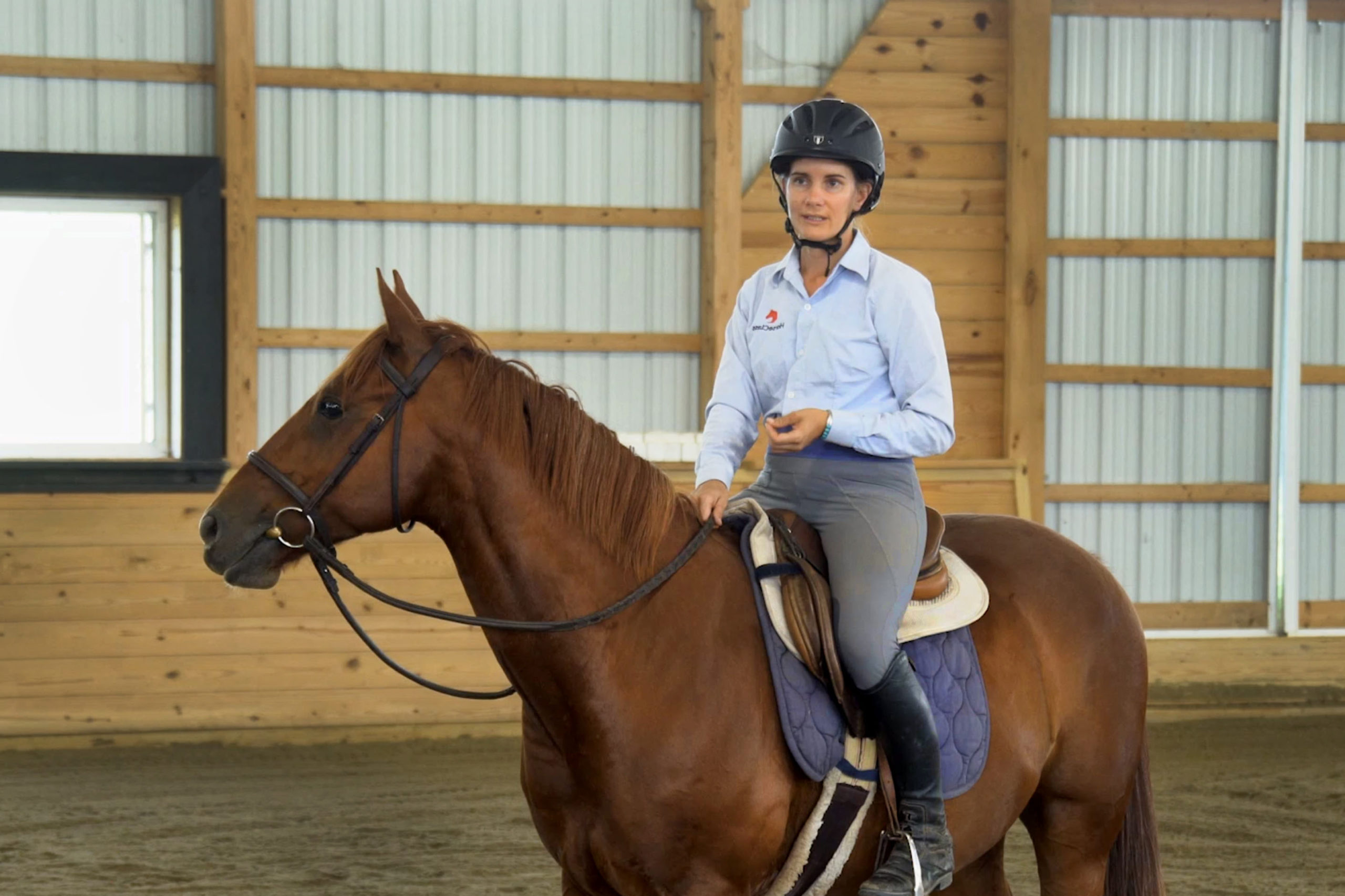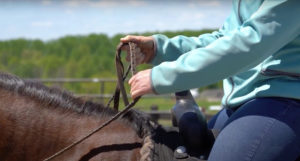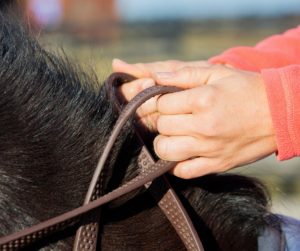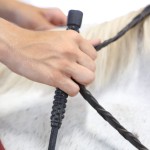Riding on a loose rein tests both our horse’s self carriage as well as our balance and ability to ride from our seat (instead of hanging on to the reins).
When I start either a new rider or a new horse, it is with a loose rein, protecting the horse’s delicate face and mouth, while developing the balance of both horse and rider independent of too much rein contact.
However, if you are thinking “I can’t let the reins too long, my horse might run off, and I feel so insecure if I don’t have contact…”, then today’s video will be very helpful.
In this video, we will discuss:
- When long reins are good and when it isn’t smart or safe to have your reins too long
- How to quickly shorten your reins
- Exercises you can do to feel comfortable with long reins and no contact
Click play below to watch the video!
After you watch the video, leave a comment below and let me know which of the exercises you found most helpful.
See you in the comments!
Callie
p.s. For more exercises like these – and a complete resource to create 100’s of training sessions to improve your riding skills – check out my book Stay in the Saddle – 67 Exercises for Horse and Rider














28 Responses
Thank you for another timely video. I feel like I ride with contact more than I should because while on a trail ride my mare bolted on me and we were off to the races while on a loose rein. I’ve spent months working with my trainer to become more confident with her again. Between your book, videos and work with him I’ve become a much better rider for my mare and feel like I can handle unexpected actions better.
I ride on the buckle a lot when hacking out and gather up the reins when I want to change gait or take more control for a particular situation. Wondering if gathering up the reins in OUR anticipation of a spook etc will teach the horse to be more anxious – i.e. picking up our anxiety?
I hack out on a loose rein as well and only gather reins to progress to trot or canter. When I approach “a spook- new grey boulder in woods” I relax reins. Horse lowers his head and “inquires” and DOES not spook. Agree with your analysis of grabbing the mouth/tight reins alerts him to anxious situation.
This video helped me understand that I am doing loose rein riding correctly. Loose in relaxed riding and a little or none but ready to make contact if needed in possible spooky areas.
Great video. The word that stuck in my mind is “micromanaging”! I am going to go out today and try different lengths. I’m sure my mare will appreciate me not being a “helicopter mom” rider!
Love the video and your explanations.
My horse is more comfortable with contact almost all the time. We’ve been working on relaxing him to accept a looser rein! This was such good info. Thanks –
I ride with a loose rein most of the time and shorten only when I need to like to get my horse’s attention . I also like to practice riding without holding the reins at all.
Great practice of syncing the horse’s foot fall and the breath. Thank you so much for your wonderful instructional videos.
As Valerie says, I’ve always wondered if shortening up the reins in anticipation of a spook would actually cause a spook? May I ask another question unrelated? I often see people riding with constant heel and lower leg movement against the horse’s sides and it confuses me. As if the horse is constantly being urged on. Can you explain the reason for this?
Thank you for this. I have a more difficult time leaning to ride with correct, soft, following contact than the loose rein. On a loopy rein I don’t have to worry about what my hands are doing. In the olden days, maybe rolling a cigarette or smoking!
I often do your exercises from your book of long and short reins and one-arm riding with my mare. However…if I ride her with long reins, she often STUMBLES and I have learned that she seems to needs= ‘holding and supporting’. Would be interested to hear your views on this. I do try to have a ‘light touch’. When I first began riding her she often snatched the reins to pull them out of my hands, but she rarely does that these days so I hope I am doing something right. Long reins seem to be a bad idea for her, unless she is just ambling back to the barn.
I always begin each ride with loose reins. When I feel that my horse is sufficiently warmed up I “pick up the reins” which signals him that I’m going to ask him to do something. My horse is a gaited horse and quite often after beginning the gait I’ll relax contact to check for self carriage. I also enjoyed your comment about “micromanaging” your horse. When we’re out on the trails and he ‘asks’ for his head it’s because he wants a better look at the footing, etc. Because of this I feel totally safe even on steep downward hills or soft ground. I’m confident in his ability to choose the right way to negotiate our way back home. That being said, I do not ride without contact on trails. We have bears, deer, foxes and the occasional mountain lion!
My horse was trained later in life after he was gelded – he still seems a bit clumsy understanding subtle aids and is heavy in the hand – I’ve found he loves the long reins to get forward and I can now slowly go back to softer contact. I’m happy my trainer has encouraged this. It’s also helped him understand my leg aids and has helped me regain balance after not riding for a number of years. I LOVE YOUR VIDEOS !!!
I have someone who is helping me to trail ride my dressage trained horse. She recommends a very tight collection with very short rein on the trail because of his tendency to take off.
He really is forward due to some anxiety or excitement. Don’t know whether I should let him look at things or just keep him looking forward. Any suggestions welcome.
My riding experience is merely half a year, so I am riding on a loose rein only in minutes of relaxation between the exercises and only in the riding arena. Thank you for the video! I am looking forward to practicing the exercises.
Thank you for the video. It showed I am still holding the reins properly. After several years of riding I was wondering if I had slipped into any bad habits. I’m a western trail rider so have always used a loose rein. I notice that people who have too much contact on their horse’s mouth the head is always bobbing & they tend to ‘jig’. Love the way you do everything in detail!!
i love riding on a loose rein, especially when i’m able to trot casually around the arena. it creates a nice intro into a work session and horse and rider are relaxed.
Hi Callie, Thanks for the great video, it couldn’t be more timely. I have a green horse that is forward and very sensitive to aids. My trainer encourages me to ride with more contact, less of a loose rein, and more leg. Her reasoning is I need to be communicating with her more since she’s an uneducated horse. An explanation of using reining and leg ques at the same time would be helpful.
All of the lessons were very informative and educational. I learned a lot.
I’ve grown perfectly comfortable riding on a loose rein in the arena. I worry more about the horse freaking out when, eg. in winter the horses become a little more playful and energized and I need to take and keep stronger contact. I fear resistance and ‘retaliation’
I know I rely on reins for a bit of balance and psychological comfort (!). Great video and exercises, thank you.
Thanks for the video Callie. I would love to ride with loose reins because this has always been my problem – to get the right amount of rein contact. I have done it with really bomb-proof horses. What I understood is that when you are cantering or jumping with “solid” horses, they expect / need a leader on its back to be “in touch” and this is done through the rein contact. Is that true? I used to ride such a horse that expected very good outside rein contact without which it would start going all over the place.
Hi Callie, interesting video. I however never ride with a lose rein, unless just finished a ride and am walking back to the stables. Sometimes on a leisurely outride with friends.
Riding with a long contact and encouraging my horses to stretch down and out, I do a lot of, but always encouraging them to reach and find contact in that long and low position. I often ride with my hands just a a few mm in front of a contact to encourage my horses to reach forward to the contact.I can understand that while riders are still establishing confidence in their own independence in the saddle, a long rein can be useful, but I wouldn’t do it for any other reason than that
Every time I ride I spend time riding on the buckle, teaching myself to use my body as well as the horse to respond to slight body movements as we turn left and right. When I first started I was amazed at the freedom of movement that I felt under me.
Very helpful video and exercises. I grew up riding Western with loose reins but am starting English-style lessons this week, and the video helped me think about the purposes of contact and also how/when to shorten a looser rein.
Alway walk and trot my horse on a loose reign as it relaxes her. Started to canter on a loose reign today, my mare puts her head really low so will take some getting used to not seeing her head! She was really unsure but seemed to be quite calm so definitely something we will keep practicing
I always start my rides on a loose rein to warm my mare up. I found out that so doing I do not try and put her on the bit before she has warmed her back and she is more relaxed and willing, and has a better activity. I walk her for 10 mn at an active walk and then I ask for 2-3 arena turns at each hand on trot and canter on a loose rein. Only after I shorten gradually the reins while keeping the activity so she takes the contact gradually and it is quite efficient this way to have her round and active at the same time.
Thanks for this informative post on the pros and cons of riding on a loose rein. Your article provides a comprehensive analysis of the advantages and considerations when riding with a loose rein, allowing riders to make well-informed decisions based on their specific circumstances. I particularly appreciate the emphasis on the benefits of allowing the horse to find balance and self-carriage while acknowledging the potential challenges of maintaining control and connection. In addition to the points discussed, I would like to highlight the potential role of the best horse calming supplements in promoting relaxation and focus during riding sessions. Incorporating a reliable calming supplement can support a calm and attentive mindset for both the horse and rider, enhancing the overall riding experience. Thank you for sharing your insights and helping riders navigate the nuances of riding on a loose rein.